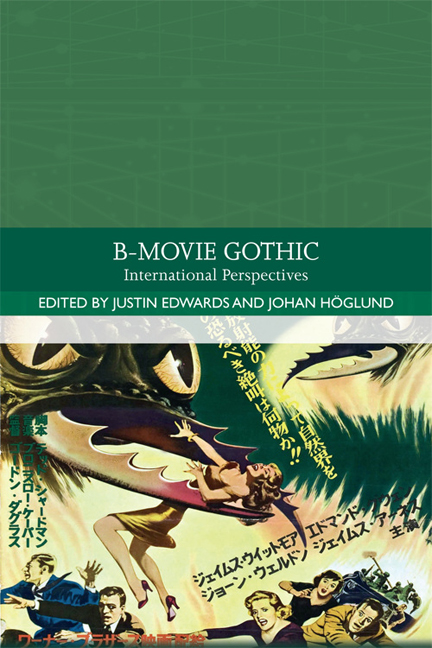Introduction: International B-Movie Gothic
Published online by Cambridge University Press: 06 May 2021
Summary
International B-movie Gothic may well seem like a fraught category: Gothic was a Western European form that spread outwards (to the USA and beyond); B-movies were originally US productions that influenced filmmakers in Western Europe and elsewhere. Gothic began in novels such as Horace Walpole's Castle of Otranto (1764) and Mary Shelley's Frankenstein (1818); it was then translated into an American texts such as Charles Brockden Brown's Wieland (1798), William Faulkner's Absalom, Absalom! (1936) and Stephen King's ‘Salem's Lot (1975). B-movies such as Jacques Tourneur's Cat People (1942) and I Walked with a Zombie (1943) developed out of the Hollywood low-budgets of the 1930s and 1940s, but evolved in the post-War period with studio pictures such as The Creature from the Black Lagoon (1954) and I Was a Teenage Werewolf (1957) before moving across the Atlantic and morphing into, for instance, British Hammer Productions such as The Curse of Frankenstein (1957), Horror of Dracula (1958) and The Mummy (1959) (Davis 2012, 1–18). On the one hand, these transatlantic movements illustrate an international dimension to Gothic and B-movies; on the other, they illustrate how Anglophone North Atlantic cultures can be consolidated into hegemonic cultural forces that extend their reach beyond the region, gaining economic and cultural dominance in other geographical locations.
In this book, we do not seek to perpetuate a cultural form of North Atlantic empire by, for instance, imposing the terms of Gothic aesthetics on Tanzanian cinema or B-movie categorisation on Indian films. Indigenous movies must be recognised on their own terms and in their own contexts, but, as with American and British B-movie Gothic, they also develop as a result of reactions to and engagement with other film cultures. International B-movie Gothic arises out of shared cinematic technologies, techniques and budgetary limitations across cultures. It also gains traction in the latter part of the twentieth century and early in the twenty-first century through filmmakers from across the globe who have begun to explore their own traditions of strange and supernatural phenomena on film, sometimes independent of North Atlantic cinematic art and sometimes influenced by it.
- Type
- Chapter
- Information
- B-Movie GothicInternational Perspectives, pp. 1 - 14Publisher: Edinburgh University PressPrint publication year: 2018

